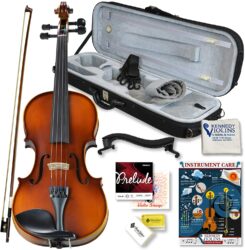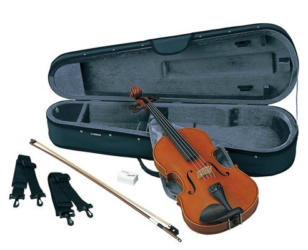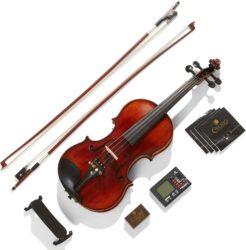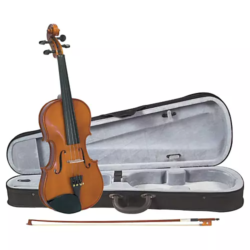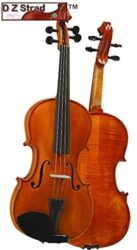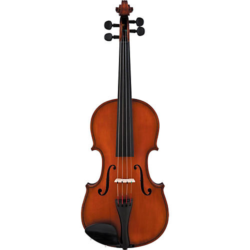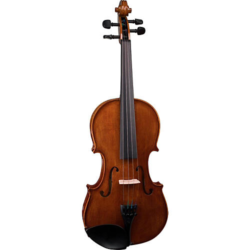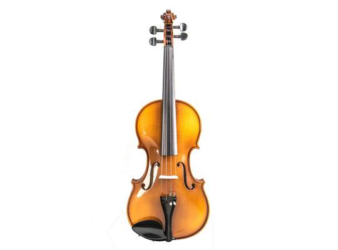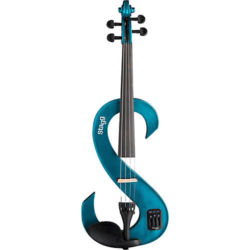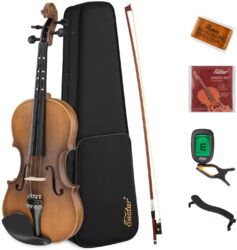You’ve made the amazing decision to learn to play the violin, one of the most beautiful yet difficult musical instruments! Becoming an expert player is a long journey, and to get through it, you need the right companion.
But how will you find the best beginner violin for you? You don’t want to buy an instrument that’s so cheaply made that you’ll hate playing it, but you also don’t want to spend a ton of money on what could end up a fleeting fancy.
We did the research to find you well-made and affordable beginner violins that will make learning to play as pleasurable as can be.
- Beginner Violin Factors to Consider
- Top 10 Best Violins for Beginners 2025
- 1. Best Overall Beginner Violin: Bunnel Pupil Violin Outfit
- 2. Best Premium Beginner Violin: Yamaha AV5 Student Violin Outfit
- 3. Best Beginner Violin Outfit: Mendini by Cecilio MV500 Violin Outfit
- 4. Best Budget Beginner Violin: Cremona SV-75 Premier Novice Violin Outfit
- 5. Best Mid-Range Beginner Violin: D Z Strad Violin Model 101
- 6. Best Beginner Violin for Easy Tuning: Knilling Perfection II Violin Outfit
- 7. Best Beginner Violin for Tinkerers: Stentor II (1500) 4-String Violin
- 8. Best European Beginner Violin: Hora V100 Student Violin
- 9. Best Electric Beginner Violin: Stagg EVN 44 Series Electric Violin Outfit
- 10. Best Ultra-Cheap Beginner Violin: Eastar EVA-3 Solid Wood Violin Set
- FAQ: Answering Your Beginner Violin Questions
- Everything a Beginner Violin Player Should Know
- Starting on a Good Note
Beginner Violin Factors to Consider
There are a few things you should know before you buy your first violin, from basic factors like size to what actually makes a good beginner violin.
Beginner Violin Size
There is no correlation between experience level and violin size. If you’re over the age of 12, a full-sized, 4/4 violin will be perfect. All of the violins we’ve selected come in this size, as well as in smaller sizes for kids. We included a size chart and some measuring guidelines in case you’re shopping for a child.
Build Quality
Most violins are made out of spruce, maple, and ebony wood. The big difference between high-quality beginner violins and cheaper ones is how the wood is aged and how the actual parts are carved and put together. A handcrafted instrument will have a nicer build than one made by machines in a factory, and as a result, it’ll have a better sound and a longer life.
Great Setup
After the violin is built, it has to be setup with pegs, strings, a bridge, and a tailpiece. A violin with a great build can be terribly hindered by poor setup. Most beginners are better off with a cheaply-made violin that’s well-setup. Violins with both a good build and a good setup are often a little more expensive, unfortunately. That’s why we included a section on basic setup followed by how to fix common issues.
Outfit and Accessories
Most beginners need a full violin outfit that includes the must-haves: the violin, a bow, and a case. There are other accessories you’ll need, like a shoulder rest and rosin, while others are extras, like a tuner or metronome. We’ll mention what accessories each violin comes with and their quality.
Strings and Bow
Two violins with a similar build can sound totally different based on their strings and bow. Most decent beginner violins come fitted with D’Addario Prelude strings, but cheaper ones come with factory-made, unidentified strings that often sound bad. We mention what type of strings and bow come with each violin and how well they perform.
Warm Sound
Beginner violins tend to have a warmer sound (we explain what that means here), but that doesn’t mean they’re all the same. What sounds beautiful to one person’s ears might not appeal to another. When possible, we’ve included links so you can hear the instrument played by a great violinist, to give you an idea of the sound quality.
Oil Varnish
The finish on your violin is more than just an aesthetic touch. It often has a big impact on your instrument’s sound quality. With beginner violins, we prefer a satin or matte oil finish because it won’t inhibit the sound. Lacquer might look nice and shiny, but it’ll often make the violin sound muted or tinny.
The Look
Beginner violins look a lot alike, regardless of the price. Most are designed to look like the iconic Stradivarius, with minor differences when it comes to wood darkness. Look at photos, and consider what peaks your fancy! If you’re shopping for a young child, a fun color might get them excited about playing, even if the instrument won’t sound as nice.
With these key factors in mind, it’s time to start our musical journey! Which beginner violin will you fall in love with?
Top 10 Best Violins for Beginners 2025
1. Best Overall Beginner Violin: Bunnel Pupil Violin Outfit
Why we like it:
With a wonderful build, exceptional setup, decent accessories, and a nice warm sound, this beginner violin has it all. It strikes an incredible balance between a low price and great quality.
Quick Specs:
- Sizes Available:4/4, ¾, ½, ¼
- Added Accessories: Bow, Rosin, Case, Extra String Set, Shoulder Rest, and Polishing Cloth
- Material:Solid Maple and Spruce, Ebony Fittings
- Look and Finish:Warm Brown With Satin Oil Finish
- How It Sounds:Youtube
- Warranty:Lifetime
- Strings:D’Addario Prelude Strings
- Bow:Giuliani Brazilwood Horsehair
Build, Setup, and Sound
We’re excited to recommend this little-known but truly exceptional violin outfit. Its price is relatively low, but the value is immense.
It’s a handmade violin with a decent build and, more importantly, an exceptional setup. It’s sold exclusively by Kennedy Violins, a store that’s run by violinists who really know what they’re doing. While they outsource the violin production, the store has in-house luthiers that do the setup on all of their violins, which seriously ups the playability and sound.
It comes out of the box pretty much ready to play! It has a warm, mellow sound that’s very forgiving. Aside from the setup, another reason for the lovely sound is that the violin has an oil finish which doesn’t hinder sound quality the way the more common varnish finish would.
Admittedly, this violin is not very resonant, and its sound projection is weak, but that’s perfectly fine for a beginner who isn’t performing yet. If you do want a violin that’ll have a bigger sound for the long term, have a look at the D Z Strad Violin Model 101 instead
Extras
This violin outfit is perfectly serviceable, with an above average case fitted with convenient extra compartments. The bow and shoulder rest are decent, and the Prelude strings are an industry staple.
Who It’s Best For
We recommend this violin to everyone, no matter their age. After a year of playing it, you can make a few small upgrades that will carry it through to your second year, as well.
Pros
- Professionally setup violin
- Warm and mellow sound
- Relatively affordable
- Outfit includes the essentials
- Lifetime warranty
Cons
- Not very loud or projective
Why we like it:
You can’t go wrong with a trusted brand like Yamaha. If you want a high-quality instrument that comes ready to play and will stay with you for years, this violin is it.
Quick Specs:
- Sizes Available: 4/4, ½, ¼, ⅛
- Added Accessories:Case, Bow, Rosin, and Wittner Tailpiece
- Material:Solid Spruce and Maple, Ebony Fittings
- Look and Finish:Oil
- How It Sounds:Youtube
- Warranty:5-Year Manufacturer’s Warranty
- Strings:D'Addario Prelude
- Bow:Brazilwood Horsehair
Build, Setup, and Sound
You’re probably familiar with Yamaha since they make so many high-quality musical instruments. Their student violins are incredibly reliable and consistent, so many violin teachers recommend them.
The AV5 impresses on multiple fronts. It’s handcrafted out of maple and spruce that were aged for 5 years, guaranteeing that it won’t warp or lose its sound over time. Most beginners find it comfortable to hold and to start playing right away.
It also comes impeccably setup and varnished with oil, so it has a fantastic warm sound. It’s very projective, so it might even work for performances.
Extras
While this outfit doesn’t include a ton of extras, the ones it does include are of excellent quality. The bow, case, and even rosin are excellent, while the strings are decent. It’s also fitted with a Wittner tailpiece with fine tuners, which makes tuning precisely much easier, especially as a beginner.
If you’d like a premium violin that’ll be even easier to tune, check out the Knilling Perfection II Violin.
Who It’s Best For
If you’re ready to start on the best foot possible, this outfit is well worth the investment. We recommend it especially to adults and older teen beginners.
Yes, it’s quite expensive, especially if you’re not certain you’d like to keep playing, but most retailers have a 45-day return policy, which might help you feel less risk-averse.
While many other beginner violins will only serve you at the very start of your journey, the Yamaha AV5 will easily suit you as you progress through the levels. Once you feel like it’s time to upgrade, you can sell it and probably not lose too much money.
Pros
- High-quality build and setup
- Beautiful warm sound
- Wittner tailpiece makes tuning a breeze
- Very comfortable to hold and play
- Good resell value
Cons
- Relatively expensive
3. Best Beginner Violin Outfit: Mendini by Cecilio MV500 Violin Outfit
Why we like it:
This affordable violin comes with everything you’ll need and then some! It also produces one of the nicest sounds we’ve heard out of a budget instrument.
Quick Specs:
- Sizes Available:4/4, ¾, ½
- Added Accessories: Two Bows, Case, Shoulder Rest, 2 Bridges, Rosin, Extra Strings, and 2-in-1 Tuner/Metronome
- Material:Solid Maple and Spruce Top, Ebony Fittings
- Look and Finish:Satin Oil Dark Wood
- How it Sounds:Youtube
- Warranty: 1-Year
- Strings:D’Addario Prelude Strings
- Bow:Brazilwood Horsehair
Build, Setup, and Sound
This affordable violin from Mendini by Cecilio has a gorgeous build and the nicest sound we’ve heard at this price point. It has a full, warm sound and excellent projection thanks to the hand-carved body and the oil finish.
The main drawback to this violin is that the setup is inconsistent, although issues are generally more likely with cheaper violins from the same series. It’s like spinning a roulette, and you might find yourself needing to get a few fixes done by a luthier, usually to lower the bridge or nut that hold up the strings.
Thankfully, the outfit comes with a warranty, so you do have some recourse if there are any severe problems.
Extras
The feature we appreciate most about this outfit is the sheer number of accessories it includes! It comes with basics like a case and bow, as well as extras that are not commonly included, like a shoulder rest and a tuner that doubles as a metronome. As you improve, you may want to switch to a better bow or a more comfortable shoulder rest, but it’s great to have so many things right off the bat.
Who It’s Best For
This kit is great for adults and older children alike. It’s especially convenient if you don’t want to spend your time hunting for all the additional violin accessories that most outfits don’t include. However, you need to be willing to take the risk of spending a bit more money on adjustments.
If you’re willing to stretch your budget just a little, we’d still recommend the Bunnel Pupil Violin Outfit over this one. However, if your budget is very tight, this is the most you can get at this price point.
Pros
- Comes with everything you need
- Warm, full sound
- Beautiful dark wood
- 1-year warranty
Cons
- Setup can be poor
4. Best Budget Beginner Violin: Cremona SV-75 Premier Novice Violin Outfit
Why we like it:
This violin outfit comes in small sizes and fun colors, so it's a nice choice for young children. It’s very affordable, so having to replace it regularly as children grow won’t be an issue.
Quick Specs:
- Sizes Available:4/4, ¾, ½, ¼, ⅛, 1/10, 1/16
- Added Accessories: Case and Bow
- Material:Solid Spruce and Maple, Dyed Hardwood Fittings
- Look and Finish: Lacquered, Comes in Sparkling Pink, Purple, Black, and Blue
- How It Sounds:Youtube
- Warranty:1-Year Manufacturer’s Warranty
- Strings:D’Addario Prelude
- Bow:Brazilwood Horsehair
Build, Setup, and Sound
The Cremona SV-75 is a quintessential beginner violin, especially for young ones. It’s widely available, incredibly affordable, and its quality is relatively consistent. Unlike many other budget instruments, it’s made of solid wood rather than laminate.
It has a mellow sound that can get a little “tinny” on the high-notes but is fine on the low registers at which beginners normally play. It’s great for the first year, but after that, you may run into issues. Also, dye might come off of the fittings or the wood may warp. Most importantly, the player’s skill will outgrow what this instrument can do.
Extras
This violin doesn’t come with much, but it does include the essentials. You’ll have to buy a rosin and shoulder rest separately. If you’d prefer a one-and-done violin shopping experience, just a little more money will get you the very full Mendini MV500 Violin Outfit.
Who It’s Best For
This is one of the few violins on our list that come in very small sizes, including 1/16 which is quite rare. For many parents, the low price on the Cremona will be helpful, since you’ll have to size up a few more times as your child grows.
Adult violinists may scoff at the colorful varnishing, but for a child, it’s a great feature. If you let your child choose a Cremona in their favorite color, they’ll be more enthusiastic to learn and practice!
If your budget isn’t too tight and you’d rather have a child-sized instrument with a better sound, the D Z Strad Model 101 is a great choice.
Pros
- Extremely affordable
- Solid wood build
- Sizes for very small children
- Exciting color choice for kids
Cons
- Mediocre sound
- Build won’t last long
5. Best Mid-Range Beginner Violin: D Z Strad Violin Model 101
Why we like it:
Everything about this violin is great, from build to setup, and it’s got a big sound. It comes in a wide range of sizes, so it’s the best option if you want your young child to play a nicer instrument.
Quick Specs:
- Sizes Available:4/4, ¾, ½, ¼, ⅛, 1/10, 1/32
- Added Accessories:Case, Bow, D’Addario Rosin, and Shoulder Rest
- Material:Solid Maple and Spruce, Ebony Fittings
- Look and Finish:Reflective Spirit Varnish
- How It Sounds:need correction
- Warranty:None
- Strings:D’Addario Prelude
- Bow:Brazilwood Horsehair
Build, Setup, and Sound
We’re getting into another teacher-favorite violin that’s on the higher side of our price range, though still affordable. This outfit is the next step up from the Bunnel Pupil Violin Outfit, with a violin that’s properly set up by an expert luthier in the US. It’s ready to play right from the box!
Compared to the Bunnel Pupil, the Model 101 has a nicer build, which corresponds with a bigger, clearer sound and also justifies the small price hike. It’s the kind of violin you will never have to “fight against” to sound good.
The only drawback to D Z Strad violins is that they don’t have a warranty. While we generally don’t expect them to have any build issues, if anything does go wrong outside the 60-day return period you won’t have much recourse.
Extras
The violin comes with a basic outfit and a shoulder rest. The quality of the added accessories blows most outfits out of the water. The bow bounces well and produces a great sound, and the shoulder rest (from a well-regarded brand) is extremely comfortable. It’s also fitted with a Wittner-style tailpiece (though not an original Wittner like the much pricier Yamaha AV5), which makes precise tuning easy.
Who It’s Best For
We think the Model 101 is a great choice for any beginner, no matter their age! It comes in sizes for very small children, so buy it if you don’t want to compromise on sound or quality either for yourself or for your child. You’ll be able to keep using it well into the intermediate stage.
Pros
- Expert US setup
- Gorgeous sound thanks to durable build
- Wittner-style tailpiece for easy tuning
- High-quality outfit
Cons
- A little pricey
- No warranty
6. Best Beginner Violin for Easy Tuning: Knilling Perfection II Violin Outfit
Why we like it:
Tuning is a breeze with the Knilling Perfection Pegs. This high-quality, mid-range violin has a great setup, and its special pegs will solve all your tuning woes.
Quick Specs:
- Sizes Available:4/4, ¾, ½
- Added Accessories:Case and Bow
- Material:Solid Spruce and Maple, Ebony Fittings
- Look and Finish:Dark Red Wood
- How It Sounds:N/A
- Warranty:Limited Lifetime Warranty
- Strings:Knilling
- Bow:Brazilwood Horsehair
Build, Setup, and Sound
Knilling Violins are an interesting choice to consider, although they come at a higher price than most beginners may want to spend.
The company is very transparent about the fact that their violins are made abroad, but they do all of their setup in the US to guarantee playability. We find that the violin has the same nice build as the Stentor II 1500, but with an excellent setup that warrants the higher price.
Extras
The most special detail about this Knilling violin is their Perfection Planetary pegs. Unlike the pegs found in most violins, these pegs are geared so they’re a little more like guitar pegs. They’re faster and easier to adjust, and the strings are less quick to go out of tune. Other violins, like the Yamaha AV5, rely on fine tuners for precision tuning, but those add bulk and can alter the sound quality of your strings.
Beyond the pegs, the outfit is fairly barebones with just a case and bow, which is unfortunate considering the price point.
Who It’s Best For
This is a great beginner violin for those who are planning to play long term. It will easily carry you through your first few years of progression, so you won’t have to spend money on replacements for a while. It’s also a wonderful choice for those suffering from arthritis or similar joint issues that can make tuning a regular violin painful.
Pros
- High-quality, long-lasting build
- Expert US setup
- Perfection pegs make tuning quick and easy
Cons
- Barebone outfit
- Slightly expensive
7. Best Beginner Violin for Tinkerers: Stentor II (1500) 4-String Violin
Why we like it:
This is a beautiful violin with a few easy-to-fix setup issues. If you’re not afraid of tinkering with your violin, you can seriously upgrade it and end up with a great instrument for little money.
Quick Specs:
- Sizes Available:4/4, ¾, ½, ¼, 1/8
- Added Accessories:Case, Bow, Rosin
- Material:Solid Maple and Spruce, Ebony Fittings, Composite Tailpiece
- Look and Finish:Satin Varnish
- How It Sounds:Youtube
- Warranty:Available for Small Cost
- Strings:Stentor
- Bow:Wood Horsehair
Build, Setup, and Sound
The Stentor does not get the credit that it deserves! For the price, it’s a well-made violin, even if it has a few issues. It’s a solid choice if you’re on a tight budget, especially if you’d like to experiment with doing your own setup adjustments.
Stentor has impeccable quality control when it comes to their builds, despite the fact that their violins are mass produced. The wood used is well-aged, so the final build is solid and durable, with a very full sound.
The biggest issue with this violin is the string quality. Their factory-made strings can sound whistle-y, so while you can make do with them for a few months, we recommend upgrading as soon as you can.
The other issue is that the setup can be poor, even if the body itself is great. You can replace the bridge and do your own peg fixes. If that’s not enough and you feel adventurous, you can watch a few luthier videos on YouTube and try to make additional fixes yourself. Alternatively, just bring it to a professional.
Extras
The Stentor 1500’s build is similar to the Mendini MV500 Violin, but without the added accessories. When choosing between the two, consider whether you’d like the big Mendini bundle with all of those extras or whether you’d rather customize your purchases.
Who It’s Best For
The Stentor isn’t playable off the bat, but with a few adjustments, it can become an amazing instrument with a higher value. If you’re handy and have some experience fiddling with musical instruments, you can make all of the changes yourself and end up with a real bargain.
Pros
- Affordable outfit
- Excellent build
- Nice choice for tinkerers
Cons
- Setup issues require small fixes
- Poor strings
- Minimal outfit
8. Best European Beginner Violin: Hora V100 Student Violin
Why we like it:
This European-made violin is a great, high-quality option. It has a beautiful sound and durable build for a mid-range price, although it comes with a small outfit.
Quick Specs:
- Sizes Available:4/4
- Added Accessories:Bow and Case
- Material:Solid Spruce and Maple, Ebony Fittings
- Look and Finish:Varnished Yellow-Brown Wood
- How It Sounds:Youtube
- Warranty:Extended Warranty Available
- Strings:Thomastik Superflexible
- Bow:Ballata Wood and Horsehair
Build, Setup, and Sound
We wanted to give you the option of a nice but not overly expensive European beginner violin, made in a more traditional workshop. It’s more expensive than mainstream violins, but we think it merits the price.
Hora violins are made in Reghin, a city in Romania with a long tradition of crafting musical instruments. Their violins have a great reputation in the EU, thanks to their long history and quality construction.
The V100 is made of solid wood sourced from the Carpathian mountains, which is aged for 5 years; this guarantees a long lifespan without warping. The sound is sweet and warm, with decent projection and resonance.
Extras
The outfit this violin comes with is minimal but decent, with a nice bow and a great protective case. However, you will need to pick up a few more essentials like rosin and a shoulder rest.
Who It’s Best For
This violin is a good choice for anyone who wants to try a European design. Since it only comes in a full-size, it’s recommended for teens and adults, and we believe the quality can last you through to intermediate violin levels.
Pros
- Handmade in Europe
- High-quality, solid build
- Warm, resonant sound
Cons
- Minimal outfit
- Only full size available
- Slightly expensive
9. Best Electric Beginner Violin: Stagg EVN 44 Series Electric Violin Outfit
Why we like it:
This electric violin is great for beginners who want to practice silently or to rock out on their violin. It comes with a full outfit for a budget-friendly price.
Quick Specs:
- Sizes Available:4/4
- Added Accessories:Bow, Soft Case, Rosin, Stereo Headphones, 9V Battery
- Material:Maple
- Look and Finish:White, Black, Violin Brown, Metallic Blue or Metallic Black
- How It Sounds:Youtube
- Warranty:1-Year Manufacturer’s Warranty
- Strings:Stagg
- Bow:Wood Horsehair
Build, Setup, and Sound
If you’re a beginner who wants to practice silently or to experiment with special effects, this budget-friendly electric violin will help!
Despite its futuristic S-shape, the Stagg EVN44 is actually made of solid maple. It has a decent construction, and while it can sometimes run into tech issues, those are usually just a sign that the battery needs replacing. How it sounds will depend on how you adjust it as well as on your amp or headphones.
Extras
The price is one of the lowest we’ve seen for an electric, and it even includes all of the basic essentials a beginner will need, as well as headphones and a 9V battery. It’s even fitted with fine tuners, which makes keeping it in tune a breeze.
Another cool feature is an additional output jack, which allows you to plug an mp3 player into the violin and hear yourself playing along with whatever music you like.
Who It’s Best For
This wouldn’t be our first pick for recording or performing, but it’s more than adequate for practice. It’s also awesome for having fun with pop or rock songs or for experimenting with effects pedals.
It only comes in a full-size, so you won’t be able to give it to a young child. It’s a little heavy, so it might also be an issue for younger teens. If you’re willing to spend more and want a lighter electric violin that’ll work for professional purposes, the Yamaha YEV-104 is a great choice, instead.
Pros
- Ideal for silent practice
- Very affordable considering it’s electric
- Outfit comes with everything you need
Cons
- Occasionally runs into tech problems
- A little heavy
- Only available in 4/4 size
10. Best Ultra-Cheap Beginner Violin: Eastar EVA-3 Solid Wood Violin Set
Why we like it:
While it’s much less impressive than the other options on this list, this violin is extremely budget-friendly, and it can work for the first few months of playing. As a bonus, the fretboard is marked with helpful finger guides.
Quick Specs:
- Sizes Available:4/4, ¾, ½, ¼
- Added Accessories:Bow, Case, Rosin, Extra Strings, Tuner
- Material:Spruce and Maple Panels, Painted Fittings
- Look and Finish:Dark Wood, Matte Finish
- How It Sounds:Youtube
- Warranty:1 Year
- Strings:Eastar
- Bow:Wood Horsehair
Build, Setup, and Sound
While it’s offered at an incredible price, there’s no denying that this violin has some problematic flaws. However, if you can’t stray from a very tight budget, or if you’re uncertain if playing violin is for you, it can be worthwhile to pick up this little guy and start playing.
Shockingly, despite the low price, the build isn’t terrible. It feels lightweight yet solid, which is quite a surprise, although it often comes with cosmetic flaws. It’s definitely not as nice as our next most affordable violin, the Cremona SV-75, but it’s acceptable. It doesn’t have much resonance or projection, but that’s to be expected.
The main issue with this violin is the nut, which is the little piece that supports the strings below the pegbox. It holds the strings a little too high which may hurt your fingers during practice. If you experience that, you can have a luthier fix the issue.
Extras
Getting so much for so little is quite a bargain! The tuner and shoulder rest that come with this violin are surprisingly good, but the bow and strings are a big disappointment.
Who It’s Best For
If your budget is very tight, this is a workable choice. Also, if you want to experiment with doing your own violin adjustments but don’t want to damage a more expensive violin, you can pick this one up and not feel too guilty if you make irreparable mistakes.
Pros
- Absurdly cheap
- Decent build
- Comes with many extras
Cons
- Strings too high
- Cosmetic flaws are common
- Very weak sound
FAQ: Answering Your Beginner Violin Questions
We’ve covered a lot so far, but the world of violins is vast and there’s always more to discover!
While you might be able to teach yourself guitar quite easily, the violin is difficult to self-teach. If you want to learn to play difficult classical pieces or join an orchestra, it’s important to learn from a professional teacher.
If you just want to have some fun, you can try and self-teach with the help of online lessons from teachers like Alison Sparrow. We still recommend setting a bit of money aside for real life lessons, just so you can get hands-on help with posture and technique. Otherwise, you might inadvertently develop bad habits and be at a greater risk of getting a repetitive strain injury.
As a beginner, you should be prepared to take care of your new prized possession. Proper maintenance will go a long way toward keeping your violin in good shape.
- After practice, always wipe down your violin gently yet thoroughly with a soft, dry cloth. Some violins come with a cleaning cloth, but if yours doesn’t, a polishing cloth for glasses will do.
- When not in use, keep your violin and bow safe and secure in their case. Make sure to loosen the hair on your bow before putting it away.
- Try to avoid putting your violin through big temperature or humidity changes. If you live in a dry climate, consider purchasing a cheap violin humidifier, which will make a big difference.
It’s always better to choose an acoustic for your starter violin. You’ll be able to play in any situation and you’ll have more access to educational materials. It’s much easier to transfer acoustic skills to an electric than vice versa.
However, some beginners might also want an electric violin like the Stagg EVN 44 Series Electric Violin on hand. The biggest benefit of an electric violin is that you can practice with headphones, and no one else will be able to hear you. This can be helpful if you want to practice at odd hours or if you live in an apartment with easily annoyed neighbors.
As you progress in your practice, you’ll hit a wall where your skill surpasses your beginner violin. You may feel this way three months in or it might take a couple of years. Let your skills guide you. If you feel like you have to fight against your violin to play more complex pieces, it’s time to upgrade.
Everything a Beginner Violin Player Should Know
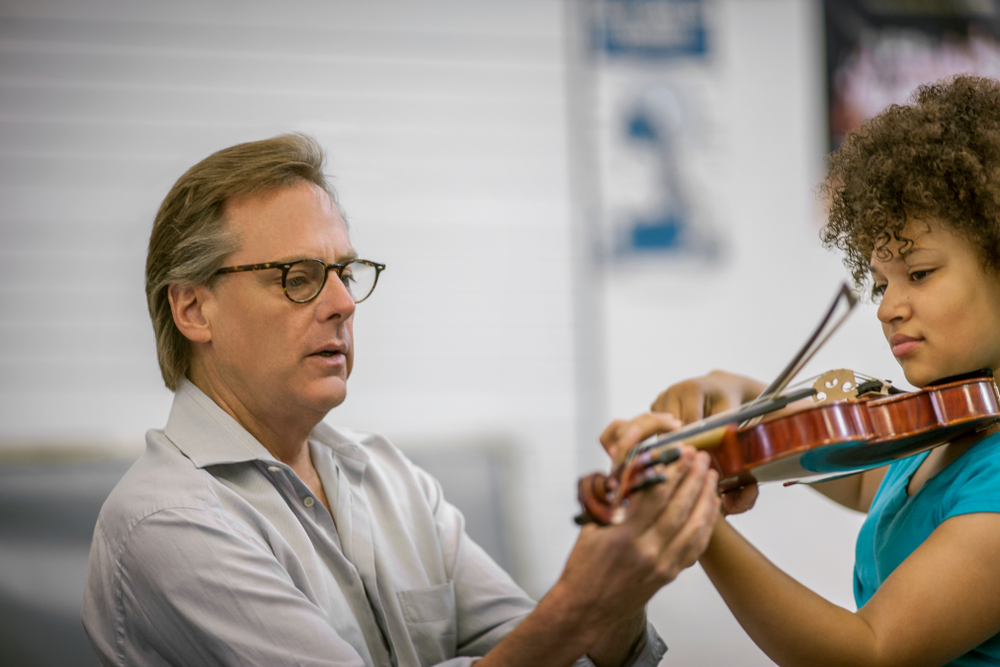
With so many violins to choose from, it’s okay if you’re feeling a little confused. With this comprehensive guide, you’ll have no problem narrowing down your selection.
Setting Your Beginner Violin Budget
It’s best to start your search with a budget in mind. Violins at similar price points tend to have a few things in common, so it’s important to understand how price correlates with quality. In general, the more expensive the violin, the better it will be.
$100 and Under
Chances are a violin under $100 won’t be worth it. In fact, you might hear the acronym VSO getting thrown around: it stands for Violin Shaped Object, which implies that though it might look like a violin, it doesn’t really count. What every violinist and teacher will tell you is that it’s better to have a VSO than to have nothing, which is why we still included the ultra-affordable Eastar EVA-3 on our list.
The issue with buying a very cheap violin is that it’ll be harder to play. Beginners may develop odd posture or bad habits to compensate for build or setup issues. Even worse is that for some, a poor instrument can be a huge deterrent to keep playing.
Young violinists might blame themselves and their lack of skill instead of blaming their VSO, and parents can often compound that blame. If you’re a parent and buy your child a VSO, it’s important to be open to upgrading within a short timeframe, if possible.
$100-$200
Now things get controversial. A lot of experienced violinists still consider violins at this price point VSOs, although we don’t think that’s true across the board.
A violin at this bracket can have a decent build and an acceptable (if not performance-ready) sound. The setup on violins at this price is often inconsistent, so you might have to take it to a luthier for a few fixes.
This might be a reasonable price-point if you’re not certain about committing to the violin yet and just want to experiment. It’s nearly guaranteed that within a year, your skills will outgrow a violin at this price.
Outfits like the Mendini MV500 and the Cremona SV-75 are the best options at this price point.
$200-$400
This is the sweet spot for beginner violins, since the quality will be much more consistent. You won’t have setup issues like wrong string height or hard-to-tune pegs. The sound might not be amazing, but it’ll be good enough to learn on.
Most importantly, you won’t find yourself itching to upgrade the violin too quickly. Often, small upgrades to the bow and strings will allow your violin to keep up with your skill for another year.
The Bunnel Pupil Violin and the D Z Strad Violin Model 101 are our two favorites at this price range.
$400-$900
At this price point, you’ll be looking at violins that can keep you company as you progress from beginner player to intermediate. They will definitely come properly set up, with high-quality outfits and a fantastic build that is always handcrafted. Most experienced players suggest buying a violin at this price point right off the bat, to guarantee that you start off on the best foot possible.
If you’re ready to invest in your future as a violinist, we recommend picking up the Yamaha AV5 Student Violin or the Knilling Perfection II Violin.
$900 and Over
Now we’re getting into the “advanced” range, and beginners don’t need such an expensive violin. At this price point, as the wood ages, the sound quality of the violin is said to improve! As you progress in your violin journey, you’ll learn that this isn’t the ceiling for violin pricing. If you’re in it for the long haul, expect to pay thousands and even tens of thousands of dollars for professional violins.
Finding the Right Size Beginner Violin
From age 12 and above, a full-sized violin will do! However, if you’re on the smaller side or shopping for a child, you can use the table below to figure out which violin size to look for.
| Size | 4/4 | 3/4 | 1/2 | 1/4 | 1/8 | 1/10 | 1/16 | 1/32 |
| Age | 12 and up | 9-12 | 7-9 | 5-7 | 4-6 | 4-5 | 3-5 | 1-3 |
| Arm Span | 23” and up | 22″-23″ | 20”-22” | 18”-20” | 16”-18” | 15”-16” | 14”-15” | 14” and under |
You’ll be able to figure out the most accurate size for you or your child by measuring arm span. Use a tape measure to measure from where the neck and shoulder connect to mid-palm. If you hit an in-between size, it’s usually better to size down unless you think your child is due for a growth spurt very soon.
Understanding Violin Anatomy
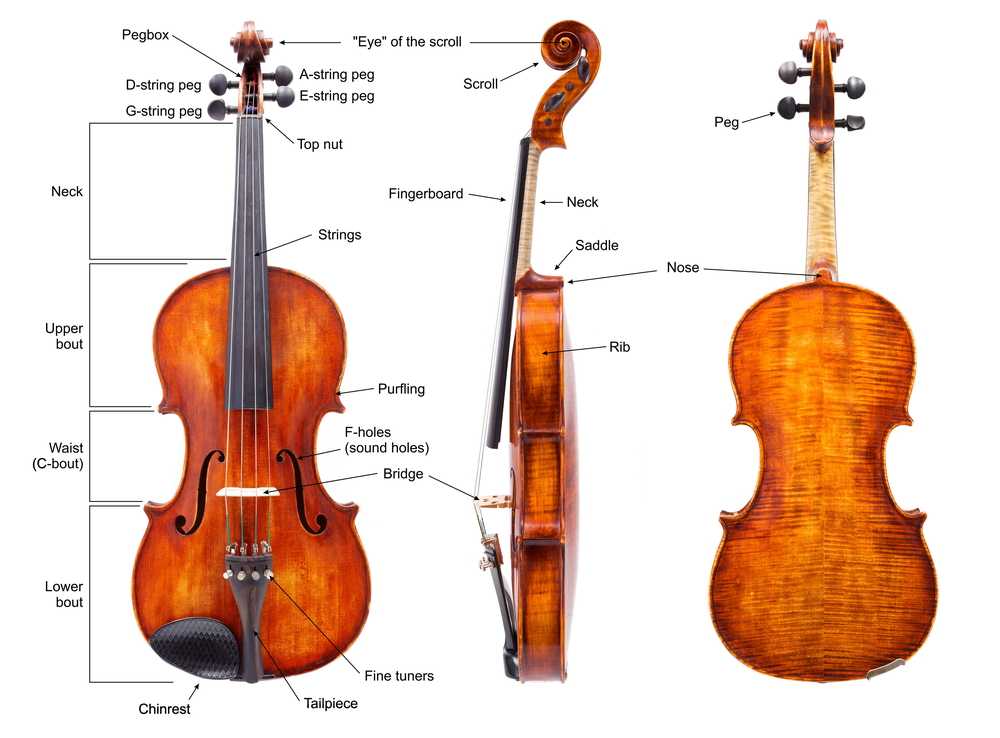
Further down, we give tips and suggestions for violin care and upgrades. In order to actually understand what we’re talking about, it’s important you know what all the different parts of the violin are called.
Bridge
A small wooden piece that maintains the tension of the strings near the bottom of the violin just above the tailpiece. If your bridge holds the strings too high your violin will be more difficult and painful to play.
Pegs
These are the main tuning mechanism on the violin. They’re fitted into a socket at the top of the violin’s neck (called the pegbox), and the strings are attached to them. When they’re turned, the strings get tighter or looser, which changes their tune.
Nut
A slightly raised piece of wood that acts as a counterbalance to the bridge, just below the pegbox.
Tailpiece
This is the piece that anchors the violin strings on the opposite end from the pegs, just below the bridge. It’s connected to the violin with an endbutton.
Fine Tuners
Nicer student violins will have a tailpiece fitted with fine tuners. They make it easier to make small tuning adjustments even while playing or practicing, and they net the player a more precise pitch. They can add a bit of weight to the violin.
Purfling
Decorative edge inlaid into the body of the violin.
Fittings
Pegs, tailpiece, chinrest, and the endbutton. These are added to the violin during setup and are normally made of ebony.
Setting Up Your Beginner Violin
Once you have your beginner violin, especially if it doesn’t come setup, you’ll have to do a few of your own adjustments.
Attaching the Bridge
If it’s not connected already, attach the bridge to your violin. Slacken the strings, and then slide the bridge under them, so that the shorter bridge side is under your G-string and the taller side is under the E-string. Line the bridge up with the little divots in the center of the F-holes, and your strings should fall into place.
Tuning Beginner Violin
Slowly tighten the pegs so that the strings will become a little tauter. While doing that, fix the bridge so it remains in place and totally upright. Then, either with a clip-on tuner or with a phone app, check the sound, and tighten the strings slowly and incrementally until each one is tuned. Keep adjusting the bridge as you tune! If your pegs keep slipping, there’s an easy fix.
Attaching Shoulder Rest
Many violins come with a shoulder rest, which is important for posture and comfort. If your violin came without a shoulder rest, we highly recommend Fiddlerman’s shoulder rest instead.
To attach, cradle your violin with its strings facing down between your right arm and your body, which will leave your right hand free to grab the end of the shoulder rest. That way, you can use both hands to attach the shoulder rest to the bottom of the violin.
Prepping the Bow
Finally, it’s essential to prep your bow. You may need to slightly tighten the hair on the bow by turning the adjustment button at the bottom, but be careful to not overdo it. Next, scrape the top layer off from your new rosin so that it’ll be easier to dispense. Then run the rosin up and down over the hair 3 or 4 times.
Seeing everything in action is always helpful, so have a look at this video:
Fixing Common Beginner Violin Issues
There are all kinds of issues you can run into with a new violin, but thankfully, they can be fixed!
Pegs Keep Slipping and Violin Won’t Stay in Tune
This is one of the most common issues with beginner violins. Usually, it’s the result of a poor setup, although it can happen even with nice instruments.
Tighten Pegs While Tuning
The simple short-term solution is to push the pegs in as you tighten them. They are simply too loose on the pegbox, so once you do that, they’ll stay in place quite well. However, this fix only works in the short term and only every once in a while. If you find yourself doing it regularly it can widen the hole in the peg box, which can make the issue worse in the long term.
Re-Roll the Strings
The best way to really fix the pegs in place is with the help of the strings. Loosen the peg while lifting the string with your finger to keep some tautness. Then, as you tighten the peg, push the string towards it. This forces the string to wind against the pegbox, which creates a wedge effect and prevents the peg from slipping out. If you’d like to see how it’s done, check out this video from Joel Kennedy:
Painful Strings – Probably a Bridge or Nut Issue
One of the most common issues with more affordable violins is that the bridge or nut are too high. This doesn’t totally hinder playability (especially when you’re only playing beginner pieces), but it can make playing a little painful since you’ll have to press harder on the strings.
Fixing a too-high bridge or nut are adjustments that a local luthier can do easily (and relatively cheaply). If you’re a brave soul with dexterous hands, you can try to whittle down the bridge yourself, although we suggest leaving nut repair to the pros.
Scratchy or Bad Sound
For your first few weeks of violin playing, you probably won’t be able to figure out if it’s your skills or the violin that is causing a scratchy sound! However, if you find it very difficult to get a nice sound, even after practicing for a while, there are a few things you can try.
More Rosin
First, you might not be using enough rosin on your bow. Because of that, your bow isn’t able to grip the strings properly. Take a bit of time to apply rosin thoroughly to your bow, and see if that fixes the issue.
New Rosin
While a lot of violin outfits include rosin, it’s often quite poor, so we recommend buying a new one that’ll do a better job and last you for literal years. Bernadel makes a medium-colored rosin that works well in most situations.
New Strings
It’s important to replace violin strings every 9 months or so. However, if the set of strings on your violin emits a scratchy or unpleasant sound, you’ll want to replace them right away.
If you’d like to seriously improve your violin’s sound, Dominant Strings are an incredible choice with a large fanbase of teachers and professional players. The D’Addario Pro Arte strings are the next step up from the Preludes and they’re also a great choice.
Replacing strings is quite easy, so you don’t have to take your violin to a luthier. Watch this video to learn how to do it:
Better Bow
It’s also possible that the bow itself just isn’t very good, which is very common with cheaper violin outfits. You’ll be surprised how much your playing will improve with a better bow! On the lower end of the price spectrum, carbon fiber bows often work better than wood ones, so we recommend the Fiddlerman Carbon Fiber Bow as an upgrade.
Understanding Violin Sounds
Sound is an intangible thing, and describing it in words isn’t always easy. Violin sounds are described with terms like “resonance,” “warmth,” and “clarity.” When you understand what they mean, you’ll know what to listen for when choosing your violin.
Resonance & Projection
Resonance is a complicated concept, but in simple terms, it refers to how loud a violin can sound. Violins can be more or less resonant at different registers, which influences their overall sound quality. Projection, on the other hand, refers to how far a sound can carry, and it’s important for performances.
Brightness
Violins with a bright sound quality have a sound that is very “clear” or “pure,” meaning that it’s true to note, especially when playing higher notes. They do an amazing job of projecting in a big hall! Most beginners stay away from bright violins, however, because they require more expertise to sound good.
Warmth
Warm violins, in contrast to bright ones, may also be referred to as “dark” or “mellow.” When you practice or play by yourself, a warm-sounding violin is much easier on the ears, which is why they are more popular for beginners. Warm violins sound best when playing lowers notes, while on higher registers they can sound muted or “muddy.”
Starting on a Good Note
There’s a lot a beginner needs to learn when shopping for their first violin, but the knowledge is invaluable. By knowing all the basics, you can choose the perfect first instrument for your needs. Now you get to start the best part–learning how to play the magnificent violin!

